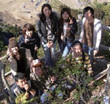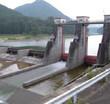
In our course, we provide education and research with the goal of creating a rich rural environment as a place for sound and healthy material circulation, preserving the rural regions where agriculture is practiced. Specifically, we carry out research and education on the appropriate and sustainable use of water, soil, and space in rural areas where the workings of nature and humans directly interact, planning the conservation for rural environments, development and management of rural areas and facilities, the effective use of regional resources, the theories and technologies required for preventing or mitigating natural disasters and recovering from them, investigation and analysis of overland and subsurface flows, and explanations and forecasts for the flow of water, chemicals, heat and gas in rural areas.
Laboratories
Applied Geomorphology

Today, many of the sensitive young people who live in an urban area take a lively interest in rural area. They move to the rural area for their livelihood and a good life. On the other hand, some human activities in rural area have been decreasing. It is deeply concerned about that it brings to decline multifunction in rural area, which are mitigation of soil erosion, groundwater storage and so on. In this laboratory, we are studying about policies for sustainable live and livelihood in the rural area, which are sustainable agriculture, food keeping for living and building a self-production system of energy. We research and educate a skill of social planning and technology in sight of water, farmland and energy in rural area.
Soil Resources Engineering

Soil resources are useful for our life. However, it sometimes causes serious disasters. Our laboratory study about disaster prevention of ground because of keeping safety and suitable life. Research topics are evaluating physical and mechanical property of soil and the characteristics of interaction problem between soil and structure. Main research projects in our laboratory are shown below;
1)We developed light weight new Jack to use for lift-up procedure of ground anchor structure (SAAM system) SAAM system is possible to evaluate the healthiness of ground anchor.
2)We developed ground improved machine with gravel column (ECOGEO). ECOGEO is possible to apply improvement of bearing capacity and drainage in the ground.
3)We research on improvement and maintenance of old ponds.
4)We evaluate shear band propagation in the ground using FE analysis and model test.
Water Resources Engineering

We are aiming to develop the conservation and recycling technology of sustainable water resources that can answer the continuing needs of the society on the basis of a quantitative grasp of the hydrological impacts including evapotranspiration and rainfall during the hydrologic process of the natural world studied mainly from the agricultural sector. To be specific, through the proposal related to the design of water storage facilities, water transmission and drainage facilities with attention paid to water quality problems such as eutrophication, etc., the proposals about environment improvement and research while paying attention to the ecosystem of the water environment, and proposals for measurement technology and facility design for contributing to watershed flood control in rural areas, the educational research also containing the evaluation method itself will be conducted based on the results above.
Terrestrial Land and Water Engineering

We will intend education and research on development of engineering management technologies for farmland soil, improvement technologies for soil degradation, international technical cooperation and others. In particular, we will intend education and research on various problems in agricultural and rural areas, NOGYO-DOBOKU (Irrigation, Drainage and Rural Engineering) as a countermeasure, land-use planning, agricultural and rural development, farmland conservation and others.
Environmental Facilities Engineering

Agricultural facilities such as dams, headworks and canals are facing various problems due to intensifying natural disasters and aging of the facilities. Advanced maintenance methods for agricultural facilities are being sought with the rapid advances in information technology. To solve these challenges, we promote practical education and research into the safety and maintenance inspection methods and appropriate new reconstruction methods in the construction and maintenance of agricultural facilities, using techniques such as materials testing, model testing, surveys and numerical analysis.
International Environment Conservation

International Environment Conservation Laboratory (IECL) deals with geotechnique, construction materials, water and environment in Rural Engineering. The mission of IECL is to protect nature and its biodiversity for the benefit of humanity by development of new construction material and technology using recycle and waste aggregate from agricultural and engineering industries. The aim is to achieving the improvement and conservation of local/regional environment and resources as well as solid waste management and recycling. Approaches are concerned with the basic and applied works based on physical and numerical analyses, field investigations and experimentations. For example, construction materials, soil and water conservation, environment protection, recycling and reusing solid wastes, slope stability, ground improvement, composite materials, soil-structure interactions, composite foundation for solar support system, are the current key research topics of IECL. Moreover, to figure out the optimal condition of environment conservation and recycling system, and to develop models for materials and disaster prevention, applications of Finite Element Method (FEM) are also used as important tools. Keywords: Environment, Geotechnique, Construction Materials, Water, Waste Aggregate, Recycling
Vadose Zone Hydrology

Soils are among the most complex systems found in nature where physical, chemical, and biological processes taking place simultaneously. Water and energy balance through the soils, especially in cryosphere, strongly affects not only local agriculture but also global climatic changes. Vadose zone hydrology and soil physics is concerned with the application of physical principles to characterization of soil properties and to understanding of processes occurring in this life-supporting thin crust of the Earth surface.
Soil Physics and Hydrology

The vadose zone, also termed the unsaturated zone, is a soil layer from the surface to the position of the groundwater, generally corresponding to the plant root zone. Unsaturated water flow, solute, heat, and gas transport with the carbon and nitrogen cycling in the vadose zone are experimentally and numerically studied. Field and laboratory experiments are conducted to intensively monitor water flow and solute transport. Numerical simulation models are developed to predict water, heat, and chemical transport with plant root uptake in a soil including nitrogen components in a solution phase and carbon dioxide in a gas phase as a result of degradation of organic matters. Furthermore, the chemical transport model is applied to predict cesium transport in agricultural fields of Fukushima area.





